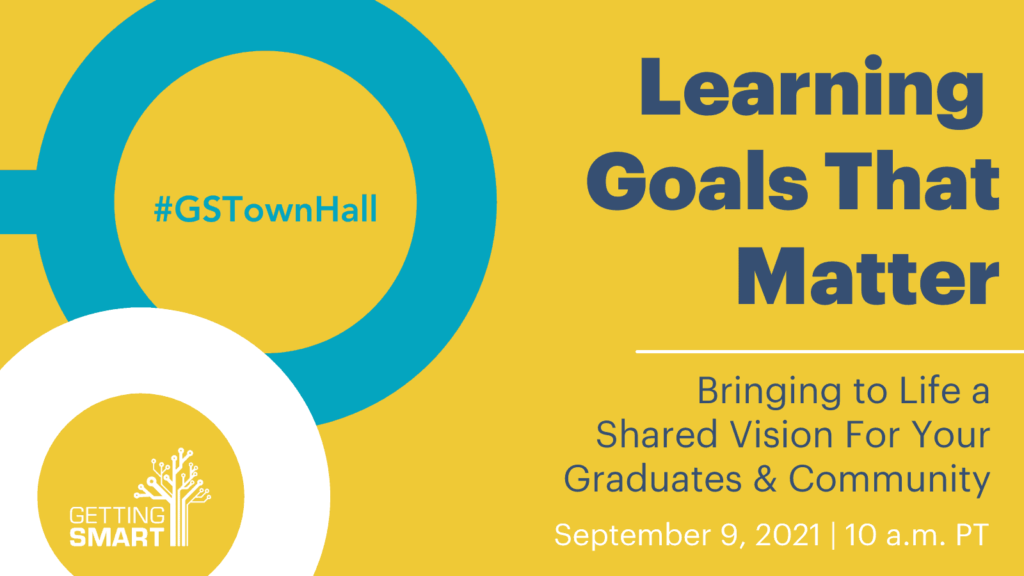Town Hall Recap: Learning Goals that Matter: Bringing to Life a Shared Vision For Your Graduates & Community

Once again, we kicked off with a poem. This one, Long, too long America by Walt Whitman.
Long, too long America,
Traveling roads all even and peaceful you learn’d from joys and prosperity only,
But now, ah now, to learn from crises of anguish, advancing, grappling with direst fate and recoiling not,
And now to conceive and show to the world what your children en-masse really are,
(For who except myself has yet conceiv’d what your children en-masse really are?)
This poem was our selection for a number of reasons — we thought it adequately captured the urgency of the topic at hand (learner goals) while also reflecting presciently on the current moment: learning from crisis. During the town hall, attendee David Richards shared: “Leaning into the crisis….the productive struggle of our current environment provides an opportunity to design new.” Lastly we thought Walt’s statement in the last sentence was strongly representative of what we should never do when developing learning goals and shared visions. It can’t all come from one figurehead — it is a communal pursuit.
We then jumped into the town hall where we unpacked “why now”, summed up well by Martin Reeves in a recent Getting Smart Podcast episode: “We need to figure out a way of harnessing imagination more effectively in order to solve our very intractable problems like inequality and global climate change […] as well as encountering surprise.”
“The skill of agency is as important as literacy,” was a great thought that surfaced during our event.
This led us into examples of Portraits of a Graduate, some tips for how to best develop them and we provided some examples as well. We then discuss how these learner goals often have different names for the same thing: Shared values, shared vision, portrait of a graduate, profile of a graduate, portrait of a learner, student learning goals and more.
Margarita Geleske said “ I love the addition of “Portrait of a Learner”. It reinforces that learning doesn’t stop at graduation.”
Seth Godin, a leading voice in learning and the next generation of creatives, says that young people need to be able to do two things in the future “lead and solve problems”. This was restated in different ways over the course of the town hall. In order to form these shared visions, an emphasis on agreement crafting is necessary.
You can check out the links mentioned in the chat here.
Questions
As always we received some outstanding questions from our attendees. Here were some of the standouts.
How difficult is the challenge to assess student progress and competency in these new and important goals? Has that level of effort been quantified?
Very. Measurement is one of the things that makes these more nimble learner goals so difficult to implement, learn from and grow. We are committed to continuing to keep learning here as portable records and transcripts get new life through new technologies and key focus areas.
How do we help our students in a VUCA (Volatile, Uncertain, Complex, Ambiguous) world?
This piece by Erin Raab does a great job of discussing how focusing on the present is the best way to prepare learners for the future.
This podcast with futurist Pavel Luksha breaks a report that identifies the most pressing skills for VUCA future.
I am wondering if we are solving the wrong problem—should we all really be investing time, effort, and money to invent our own customized PoGs? While districts and communities are different, most of the things we want students to learn are actually the same (right?). Students in California, Ohio, Vermont, and every other state all need to learn collaboration, critical thinking, creativity, etc. When looking at all these state and district profiles, at least 80% are the same. Rather than everyone creating their own profiles, why aren’t we all leveraging common ones?
One attendee responded to this question by saying: “The POG process is more critical than the final product.”
Someone else responded with: “ I agree and disagree. The process lays down a critical foundation for stakeholder engagement, but the product becomes the North Star for whole child outcomes for ALL students. It too is essential!”
Conclusion
To take this topic even further, Getting Smart is excited to announce a new offering: a Smart Sprint on Building a Shared Vision. This two week design sprint will bring together edleaders and educators to design, iterate and refine design principles and a shared vision to bring back with them to their district and beyond. We hope you’ll consider registering to collaboratively build shared visions and design principles!
Next month our town hall will be on 10/7 and will be an Ask Me Anything (AMA) session with the Getting Smart Team focusing on implementing innovations, systems leadership and more. Feel free to email questions to Mason in advance.





Swasthya
Great article thanks for sharing this great Information